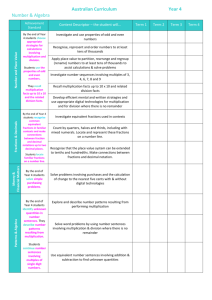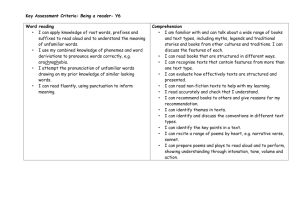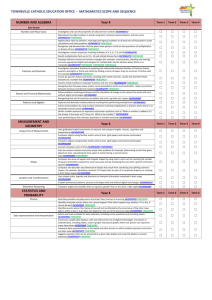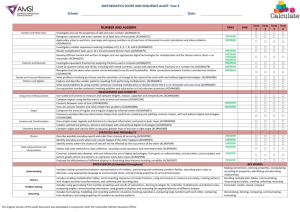PUMA termly content for Y6
advertisement
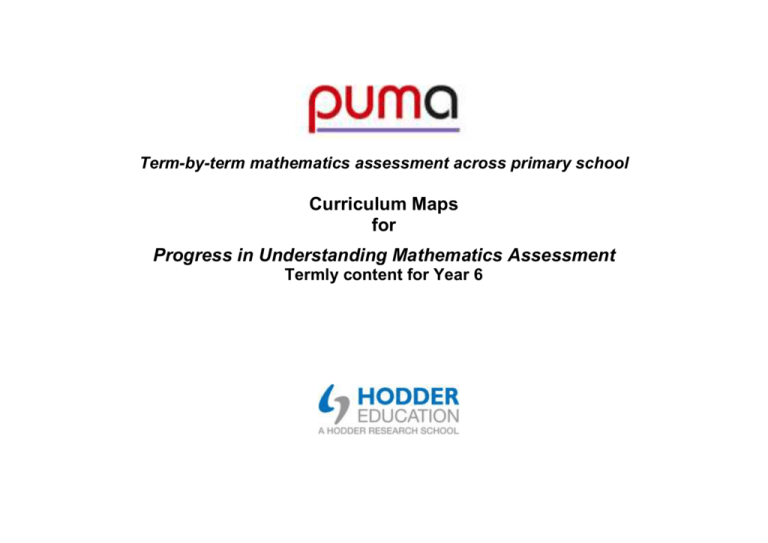
Term-by-term mathematics assessment across primary school Curriculum Maps for Progress in Understanding Mathematics Assessment Termly content for Year 6 The PUMA tests provide thorough coverage of the new National Curriculum Programme of Study for the particular year. These Curriculum Maps take in the new PoS, which describes what should be covered by the end of each year, and suggest how teaching of the material might be allocated to each term. For any test to give reliable results, it needs to be valid – that is, to assess what has been taught – so the Curriculum Maps help to define what PUMA assesses each term. We hope that you will find the Curriculum Maps useful in planning your teaching and for liaison across the school. The PUMA test for each term includes much, but obviously not all, of the curriculum we have described for that term. We anticipate that much of the material is introduced in the Autumn term and reinforced in subsequent terms. Blue highlighting denotes specific material moved down from a higher year. Yellow highlighting denotes content not explicit in the PNS for the year, to help you transfer from your existing lesson planning. Purple text denotes repeated statements. Italics indicate illustrative examples, non-statutory notes and guidance from the new PoS. (NB most of the non-statutory notes and guidance are new, from a higher year, or beyond the PNS.) You will notice a lot of yellow highlighting, to make you aware of even very small changes. It often indicates little more than an expansion and clarification of what you would already be teaching using the PNS. We have also highlighted the same material in all 3 terms, where it is typically taught in the autumn term, but used and reinforced in subsequent terms. Y6 section NUMBER Number and place value Autumn Addition, subtraction, multiplication and division Spring Read, write, order and compare numbers up to 10 000 000 and determine the value of each digit e.g. What must be added to 26 523 to change it to 54 525? Round any whole number to a required degree of accuracy e.g. round 265 496 to the nearest 10 000 (270 000) Solve number and practical problems that involve number, place value and rounding e.g. What is the largest 5-digit number whose digits sum to 20? (99200). Continue to use all the multiplication tables to 12 × 12 in order to maintain their fluency e.g. 84÷12 Continue to practise the four operations for larger numbers using the formal written methods of columnar addition and subtraction, short and long Summer Read, write, order and compare numbers up to 10 000 000 and determine the value of each digit Read, write, order and compare numbers up to 10 000 000 and determine the value of each digit Round any whole number to a required degree of accuracy e.g. Give an example of a number which you might round to the nearest 10? Nearest 10 000? Round any whole number to a required degree of accuracy e.g. What is the smallest number which rounds to 500 000, to the nearest 1000? (499 500). Use negative numbers in context, and calculate intervals across zero e.g. how much warmer is 5°C than -4°C? (9°C) Use negative numbers in context, and calculate intervals across zero Solve number and practical problems that involve number, place value and rounding e.g. What is the smallest number which rounds to 35 000, to the nearest 1000? (34 500). Solve number and practical problems that involve number, place value and rounding e.g. What is the smallest 4-digit integer whose digits sum to 20? (10199). Continue to use all the multiplication tables to 12 × 12 in order to maintain their fluency Continue to use all the multiplication tables to 12 × 12 in order to maintain their fluency Continue to practise the four operations for larger numbers using the formal written methods of columnar addition and subtraction, short and long multiplication, and short and long Continue to practise the four operations for larger numbers using the formal written methods of columnar addition and subtraction, short and long multiplication, and short and long multiplication, and short and long division Multiply multi-digit numbers up to 4 digits by a two-digit whole number using the formal written method of long multiplication Perform mental calculations, including with mixed operations and large numbers e.g. (13 500 × 2) ÷ 9 = 3000 Solve addition and subtraction multi-step problems in contexts, deciding which operations and methods to use and why e.g. There are 6534 cars parked in a 3-storey car park; 1398 are on the first floor and 3765 are on the second floor; how many cars are parked on the third floor? Solve problems involving addition, subtraction, multiplication and division e.g. 396 children and 37 adults went on a school trip; buses seat 57 people; how many buses were needed? Use estimation to check answers to calculations and determine, in the context of a problem, levels of accuracy. e.g. find the perimeter of a football pitch with side lengths division division Multiply multi-digit numbers up to 4 digits by a two-digit whole number using the formal written method of long multiplication Multiply multi-digit numbers up to 4 digits by a two-digit whole number using the formal written method of long multiplication Perform mental calculations, including with mixed operations and large numbers Perform mental calculations, including with mixed operations and large numbers e.g. (13 400 + 10 600) × 4 ÷ 12 = 8000 Solve addition and subtraction multi-step problems in contexts, deciding which operations and methods to use and why e.g. Three people won £365 496 on the lottery; one received £197 540, another received £40 010; how much did the third person receive? Solve addition and subtraction multi-step problems in contexts, deciding which operations and methods to use and why e.g. Write a number story for this number sentence: 23.5 = 20.4 + 4.9 - 1.8 Solve problems involving addition, subtraction, multiplication and division e.g. Club A sold 3500 tickets for £9.50 each and Club B sold 8150 tickets for £3.50; how much more money did Club A make than Club B? Use estimation to check answers to calculations and determine, in the context of a problem, levels of accuracy Identify common factors, common multiples and prime numbers e.g. Solve problems involving addition, subtraction, multiplication and division e.g. I think of a number and subtract 5.6 from it then multiply the result by 6; the answer is 7.2; what was my number? Use estimation to check answers to calculations and determine, in the context of a problem, levels of accuracy e.g. A box contains approximately 52 matches; how many boxes can be filled with 10 105.3m and 46.8m (estimate: (105+45)×2=300m; actual: (105.3+46.8)×2=304.2m (same number of decimal places as numbers in the question) Identify common factors, common multiples and prime numbers e.g. common factors of 12 and 15 are 1 and 3; common multiples of 4 and 6 are 12, 24, 36…; prime numbers are numbers with exactly 2 factors e.g. 2, 3, 5, 7, 11, 13, … 000 matches? Identify common factors, common multiples and prime numbers e.g. Find the smallest common multiple of 5, 6 and 8 (120) Find the highest common factor of 120, 90 and 75 (15) or Find all the prime numbers between 80 and 100. Divide numbers up to 4 digits by a two-digit whole number using the formal written method of long division, and interpret remainders as whole number remainders, fractions, or by rounding, as appropriate for the context Use their knowledge of the order of operations to carry out calculations involving the four operations and using brackets e.g. 14 x (29 – 12) + 7 = 245 Divide numbers up to 4 digits by a two-digit whole number using the formal written method of long division, and interpret remainders as whole number remainders, fractions, or by rounding, as appropriate for the context Use their knowledge of the order of operations to carry out calculations involving the four operations and using brackets; e.g. 2 + 1 x 3 = 5 and (2 + 1) x 3 = 9. Use common factors to simplify fractions; use common multiples to express fractions in the same denomination Use common factors to simplify fractions; use common multiples to express fractions in the same denomination List equivalent fractions to identify fractions with common denominators List equivalent fractions to identify fractions with common denominators Compare and order fractions, including fractions >1 e.g. put Compare and order fractions, including fractions >1 e.g. put FRACTIONS Fractions (including decimals and percentages) Use common factors to simplify fractions e.g. as the numerator and denominator have a common factor of 4, 12/16 can be simplified to 3/4; use common multiples to express fractions in the same denomination e.g. as the denominators have a common multiple of 12, 3/4 and 5/6 can both be expressed in twelfths i.e. 9/12 and 10/12 respectively List equivalent fractions to identify fractions with common denominators Compare and order fractions, including fractions >1 e.g. put these fractions in order from the smallest: 5/4, 5/8, 3/2, 14/8 Identify the value of each digit to three decimal places and multiply and divide numbers by 10, 100 and 1000 where the answers are up to three decimal places e.g. 205.6 ÷ 100 =2.056 Multiply one-digit numbers with up to two decimal places by whole numbers e.g. 0.6 x 7 these fractions in order from the smallest: 5/4, 5/6, 3/2, 4/3 Recall and use equivalences between simple fractions, decimals and percentages, including in different contexts e.g. order 4/5 , 75%, 0.9, 19/20 these fractions in order from the smallest: 5/4, 5/6, 3/5, 4/3 Associate a fraction with division and calculate decimal fraction equivalents e.g. 0.375 for a simple fraction e.g. 5/8 Associate a fraction with division and calculate decimal fraction equivalents e.g. 0.375 for a simple fraction e.g. 5/8 Use understanding of relationship between unit fractions and division to work backwards by multiplying a quantity that represents a unit fraction to find the whole quantity e.g. if ¼ of a length is 36cm, then the whole length is 36 × 4 = 144cm Use understanding of relationship between unit fractions and division to work backwards by multiplying a quantity that represents a unit fraction to find the whole quantity e.g. if 1/5 of a mass is 150g, then the whole mass is 150 × 5 = 750g Add and subtract fractions with different denominators and mixed numbers, using the concept of equivalent fractions e.g. 1/2 + 1/8 = 5 /8 Add and subtract fractions with different denominators and mixed numbers, using the concept of equivalent fractions e.g. 13/4 - 5/6 = 11 /12 Identify the value of each digit to three decimal places and multiply and divide numbers by 10, 100 and 1000 where the answers are up to three decimal places e.g. × 100 = 140.8 Use a variety of images to support understanding of multiplication with fractions Multiply simple pairs of proper fractions, writing the answer in its simplest form e.g. ¼ × 1/2 = 1/8 Divide proper fractions by whole numbers e.g. 1/3 ÷ 2 = 1/6 Identify the value of each digit to three decimal places and multiply Multiply one-digit numbers with up to two decimal places by whole numbers e.g. 0.06 x 8 Use written division methods in cases where the answer has up to two decimal places e.g. 458 ÷ 8 = 57.25 Ratio and proportion Solve problems involving the relative sizes of two quantities where missing values can be Multiply and divide numbers with up to two decimal places by onedigit and two-digit whole numbers e.g. 3.15 × 62 Solve problems which require answers to be rounded to specified degrees of accuracy and check the reasonableness of answers. Recall and use equivalences between simple fractions, decimals and percentages, including in different contexts. e.g. find a fraction which lies between 0.4 and 0.5 Solve problems involving the relative sizes of two quantities where missing values can be and divide numbers by 10, 100 and 1000 where the answers are up to three decimal places e.g. ÷ 1000 = 0.45 Multiply one-digit numbers with up to two decimal places by whole numbers e.g. 0.04 x 12 Use written division methods in cases where the answer has up to two decimal places e.g. 693 ÷ 15 = 14.2 Multiply and divide numbers with up to two decimal places by onedigit and two-digit whole numbers e.g. 93.15 ÷ 5 Solve problems which require answers to be rounded to specified degrees of accuracy and check the reasonableness of answers. Recall and use equivalences between simple fractions, decimals and percentages, including in different contexts e.g. find a decimal which lies between 3 /8 and ½ Solve problems involving the relative sizes of two quantities where missing values can be found by using integer multiplication and division facts e.g. adjust a recipe for 4 people, to serve 20 people found by using integer multiplication and division facts e.g. adjust a recipe for 4 people, to serve 6 people found by using integer multiplication and division facts e.g. adjust a recipe for 6 people, to serve 15 people Solve problems involving similar shapes where the scale factor is known or can be found e.g. two rectangular picture frames are the same shape, but one is bigger than the other; the smaller one measures 10cm by 15cm; the larger frame has a width of 30cm, what is its length? Solve problems involving similar shapes where the scale factor is known or can be found e.g. On a map 2cm represents 1km; a road measures 7cm on the map, how long is it in real life? Use the notation a : b to record ratio Begin to use the notation a : b to record ratio Solve problems involving the calculation of percentages (e.g. measures) such as 15% of 360 and the use of percentages for comparison Solve problems involving the calculation of percentages (e.g. measures) such as 15% of 360 and the use of percentages for comparison Link percentages of 360° to calculating angles of pie charts Solve problems involving unequal sharing and grouping using knowledge of fractions and multiples e.g. the ratio of boys to girls in class 6 is 1:2; there are 8 boys, how many girls are there?. Link percentages of 360° to calculating angles of pie charts Solve problems involving unequal sharing and grouping using knowledge of fractions and multiples e.g. for every egg you need three spoons of flour; how many eggs are needed for 12 spoons of flour? Algebra Use symbols and letters to represent variables and unknowns in mathematical situations… o missing numbers, lengths, coordinates and angles e.g. 3x=24 or the angles in a triangle are 35°, 120° and y°; find y o o Use symbols and letters to represent variables and unknowns in mathematical situations… o missing numbers, lengths, coordinates and angles e.g. 5y+1=16 or the angles in an isosceles triangle are 50°, y° and y°; find y o mathematics and science formulae e.g. P=2(l+w) o arithmetic rules e.g. a×b=b×a o generalising number patterns e.g. 3, 6, 9, 12, … 3n o number puzzles e.g. a+b=8.5 and a×6=15; find a and b Use symbols and letters to represent variables and unknowns in mathematical situations… o missing numbers, lengths, coordinates and angles e.g. 68=6t-4 or the angles in a kite are x°, x°, 15° and 53°; find x, or plot points (x, y) where x+y=10 o mathematics and science formulae e.g. A=½(l×h) o arithmetic rules o generalising number patterns e.g. 6, 11, 16, 21, … 5n+1 o number puzzles e.g. x+y=10 and 2x+y=13; find x and y Express missing number problems algebraically e.g. the perimeter of a triangle is 20cm; it has two sides of length 8cm; what is the length of the other side? (20=2×8+x so x=4cm) Express missing number problems algebraically e.g. I’m thinking of a number; I double it and subtract 12 from the result; the answer is 60; what was my number? (2x-12=60, so 2x=72, so x=36) Use simple formulae expressed in words e.g. write a formula for the cost of a party, C, which costs £100 plus £2 per person, n. (C=100+2n) Use simple formulae expressed in words e.g. write a formula for the cost of a taxi journey, C, which is £2.10 plus £1.60 per kilometre, k. (C=2.10+1.60k) Enumerate all possibilities of combinations of two variables e.g. mathematics and science formulae e.g. A=l×w arithmetic rules e.g. a+b=b+a Express missing number problems algebraically e.g. 17 = x + 4.5 Use simple formulae expressed in words e.g. write a formula for the number of months, m, in y years. (y=12m) Enumerate all possibilities of combinations of two variables e.g. investigate how many different ways 2 red eggs can be placed in a 6-space egg carton, by starting with a 3-space carton, 4-space carton etc? Enumerate all possibilities of combinations of two variables e.g. investigate all possible half-time scores when the full time score of a football match is 4:2 Generate and describe linear number sequences e.g. write the first 5 terms in a ‘decrease by 9’ sequence starting from 20, or find the nth term of a simple sequence e.g. 4, 8, 12, 16, … 4n list all the combinations of boys and girls in a class where there are twice as many boys as girls and between 25 & 35 children in the class altogether. Generate and describe linear number sequences e.g. 6, 13, 20, 27, … 7n-1 Find pairs of numbers that satisfy number sentences involving two unknowns. e.g. a – b = 5, give pairs of values that a and b could have (e.g. 8, 3 or 6.5, 1.5 or …) or. p×q=24; if p and q are both positive, even numbers, list all the possible combinations (e.g. 2×12, 4×6, …) Find pairs of numbers that satisfy number sentences involving two unknowns. e.g. a – b = 5, give pairs of values that a and b could have (e.g. 8, 3 or 6.5, 1.5 or …) Use, read, write and convert between standard units, converting measurements of length, mass, volume and time from a smaller unit of measure to a larger unit, and vice versa, using decimal notation to three decimal places Use, read, write and convert between standard units, converting measurements of length, mass, volume and time from a smaller unit of measure to a larger unit, and vice versa, using decimal notation to three decimal places Recognise that shapes with the same areas can have different perimeters and vice versa e.g. investigate triangles with areas of 12cm2 to find which has the Recognise that shapes with the same areas can have different perimeters and vice versa e.g. investigate parallelograms with areas of 24cm2 to find which has MEASUREMENT Measurement Use, read, write and convert between standard units, converting measurements of length, mass, volume and time from a smaller unit of measure to a larger unit, and vice versa, using decimal notation to three decimal places e.g. 4.52kg = 4520g; 1.005km = 1005m Recognise that shapes with the same areas can have different perimeters and vice versa e.g. investigate rectangles with areas of 24cm2 to find which has the smallest perimeter smallest perimeter Recognise when it is possible to use formulae for area of shapes e.g. find the length of rectangle which is 4m wide and has the same area as a square with a side length of 8cm. Recognise when it is possible to use formulae for area and volume of shapes e.g. find the length of the side of a cube with a volume of 27cm3 Calculate the area of parallelograms and triangles, relating it to the area of rectangles, e.g. compare the ‘counting squares’ method to using the formula for the area of a parallelogram Calculate the area of triangles, relating it to the area of rectangles, e.g. compare the ‘counting squares’ method to using the formula for the area of a triangle Solve problems involving the calculation and conversion of units of measure, using decimal notation to three decimal places where appropriate e.g. Ben walked 850m to the bus stop, travelled on a bus for 8.67km and then a train for 120.9km; how far did he travel altogether? Convert between miles and kilometres and other units commonly used e.g. know that a mile is approximately 1.6km (and 1km is approximately 0.6miles) and use this to make rough calculations Calculate, estimate and compare the smallest perimeter Recognise when it is possible to use formulae for area and volume of shapes e.g. find the height of cuboid which is 12cm long, 2cm high and has the same volume as a cube with sides of 6cm Calculate the area of parallelograms and triangles, relating it to the area of rectangles Solve problems involving the calculation and conversion of units of measure, using decimal notation to three decimal places where appropriate e.g. A jug holds 550ml; how may jugs of water are needed to fill a 4.8 litre bucket? convert between miles and kilometres and other units commonly used e.g. use a conversion line graph or be able to work out that 6 pints of milk is a bit more than 3 litres calculate, estimate and compare volume of cubes and cuboids using standard units, including 3 centimetre cubed (cm ) and cubic 3 metres (m ) and extending to 3 3 other units, such as mm and km . volume of cubes and cuboids using standard units, including 3 centimetre cubed (cm ) and cubic Begin to use compound units for speed e.g. miles per hour Draw 2-D shapes using given dimensions and angles using measuring tools and conventional markings and labels for lines and angles e.g. construct a triangle or complete a parallelogram with given lengths and angles Recognise, describe and build simple 3-D shapes, including making nets Compare and classify geometric shapes based on their properties and sizes and find unknown angles in any triangles, quadrilaterals, and regular polygons Recognise angles where they meet at a point, are on a straight line, or are vertically opposite, and find missing angles describing them algebraically e.g. a=180(b+c) Illustrate and name parts of 3 metres (m ) and extending to 3 3 other units, such as mm and km . GEOMETRY Properties of shapes Draw 2-D shapes using given dimensions and angles using measuring tools and conventional markings and labels for lines and angles e.g. same length lines, parallel lines and same size angles: Draw 2-D shapes using given dimensions and angles using measuring tools and conventional markings and labels for lines and angles e.g. complete a triangle with given lengths and angles Recognise, describe and build simple 3-D shapes, including making nets e.g. visualise 3-D shapes drawn on isometric paper and begin to draw 2-D representations of 3-D shapes Recognise, describe and build simple 3-D shapes, including making nets e.g. investigate different nets for a cube, recognising when ‘nets’ will fold to make a cube and when they will not. Compare and classify geometric shapes based on their properties and sizes (e.g. parallel sides, line symmetry, types of angles etc) and find unknown angles in any triangles, quadrilaterals, and regular polygons Recognise angles where they meet at a point, are on a straight line, or are vertically opposite, and find missing angles describing them algebraically e.g. a=180- (b+c). Position and direction Describe positions on the full coordinate grid (all four quadrants) e.g. (-3, 7) Draw and translate simple shapes on the coordinate plane, and reflect them in the axes. Predict missing coordinates of quadrilaterals by using the properties of shapes, which may be expressed algebraically e.g. translating vertex (a, b) to (a-2, b+3), or find the other vertices of a square, given two of them are (a, b) and (a+d, b+d) circles, including radius, diameter and circumference and know that the diameter is twice the radius describing it algebraically as d=2×r Describe positions on the full coordinate grid (all four quadrants) Describe positions on the full coordinate grid (all four quadrants) Draw and translate simple shapes on the coordinate plane, and reflect them in the axes. Draw and translate simple shapes on the coordinate plane, and reflect them in the axes. Predict missing coordinates of quadrilaterals by using the properties of shapes, which may be expressed algebraically e.g. translating vertex (a, b) to (a-2, b+3), or find the other vertices of a square, given two of them are (a, b) and (a+d, b+d) Predict missing coordinates of quadrilaterals by using the properties of shapes, which may be expressed algebraically e.g. translating vertex (a, b) to (a-2, b+3), or find the other vertices of a square, given two of them are (a, b) and (a+d, b+d) Draw and label a pair of axes in all four quadrants with equal scaling. Calculate and interpret the mean as an average. Interpret and construct pie charts and line graphs and use these to solve problems e.g. connect conversion from kilometres to miles in measure to its graphical representation. STATISTICS Use and interpret data Interpret and construct pie charts and line graphs and use these to solve problems e.g. draw a pie chart to show how Jack spends his £36 birthday money: o £9 snacks o £15 toys o £12 books Encounter and draw graphs Calculate and interpret the mean as an average. e.g. find the mean height of these children: 1.2m, 1.07m and 1.12m Interpret and construct pie charts and line graphs and use these to solve problems e.g. create a conversion graph for pounds and Euros relating two variables, arising from their own enquiry and in other subjects e.g. a scattergraph connecting heights of children and their long-jump distance Encounter and draw graphs relating two variables, arising from their own enquiry and in other subjects. Encounter and draw graphs relating two variables, arising from their own enquiry and in other subjects.
